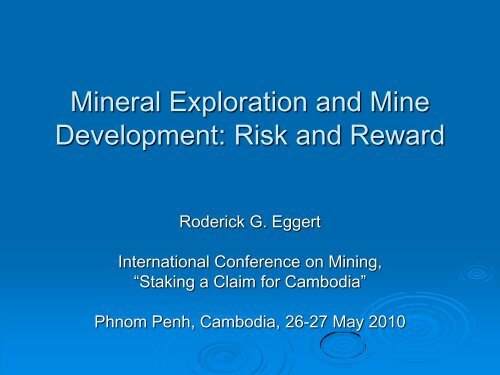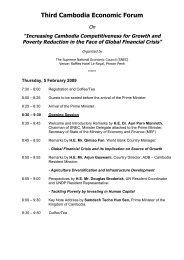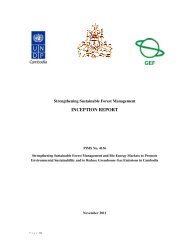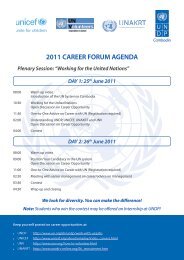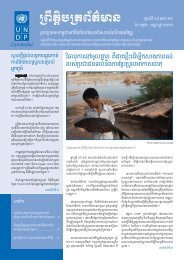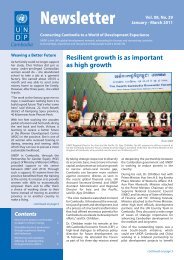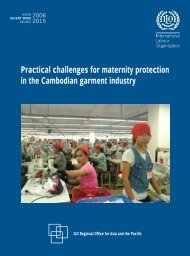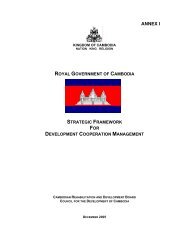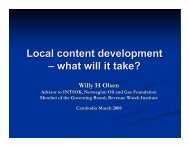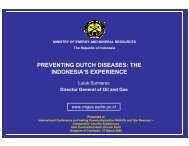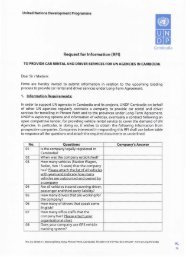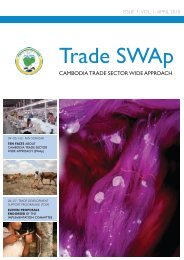5.Roderick Eggert_Exploration and Development.pdf
5.Roderick Eggert_Exploration and Development.pdf
5.Roderick Eggert_Exploration and Development.pdf
Create successful ePaper yourself
Turn your PDF publications into a flip-book with our unique Google optimized e-Paper software.
Mineral <strong>Exploration</strong> <strong>and</strong> Mine<br />
<strong>Development</strong>: Risk <strong>and</strong> Reward<br />
Roderick G. <strong>Eggert</strong><br />
International Conference on Mining,<br />
“Staking a Claim for Cambodia”<br />
Phnom Penh, Cambodia, 26-27 May 2010
Outline for “Mineral <strong>Exploration</strong> <strong>and</strong><br />
Mine <strong>Development</strong>”<br />
‣ Characteristics<br />
‣ Where they occur<br />
‣ How they are financed<br />
‣ „Best practice‟ in public policy<br />
Roderick G. <strong>Eggert</strong>, May 26, 2010 2
Mineral <strong>Exploration</strong> <strong>and</strong> Mine<br />
‣ . . .are investments<br />
<strong>Development</strong>. . .<br />
‣ They compete for funds with other<br />
investment opportunities<br />
‣ The level <strong>and</strong> location of investment are<br />
determined by expected revenues <strong>and</strong><br />
costs, adjusted for time <strong>and</strong> risk<br />
Roderick G. <strong>Eggert</strong>, May 26, 2010 3
‣ Geologic<br />
Factors that Determine Expected<br />
Revenues, Costs, <strong>and</strong> Risks<br />
• Does a mineral resource exist, in what quantities <strong>and</strong> grades, of<br />
what metallurgical quality<br />
‣ Technical<br />
• Can a resource be extracted <strong>and</strong> processed, with what<br />
technologies<br />
‣ Environmental, Social, <strong>and</strong> Political<br />
• Can a resource be extracted in ways that are consistent with a<br />
nation‟s preferences for environmental quality <strong>and</strong> impacts on<br />
local communities And in ways that are compatible with public<br />
policies <strong>and</strong> the political environment<br />
‣ Economic<br />
• Overall, can a resource be extracted at a profit<br />
Roderick G. <strong>Eggert</strong>, May 26, 2010 4
Mineral <strong>Exploration</strong> <strong>and</strong> Mine<br />
<strong>Development</strong>. . .<br />
‣ . . . together represent a multistage<br />
process of information gathering<br />
Roderick G. <strong>Eggert</strong>, May 26, 2010 5
Stages in Mineral Supply<br />
(1) Grassroots <strong>and</strong> advanced exploration identifying <strong>and</strong><br />
evaluating a mineral deposit<br />
(2) Deposit development designing <strong>and</strong> constructing a mine<br />
(3) Mining producing ore & concentrate (or other form of semiprocessed<br />
material)<br />
(4) Metallurgical processing producing refined metal<br />
(5) Fabrication <strong>and</strong> manufacturing transforming refined metal into<br />
finished product<br />
The perspective of mineral deposit: the deposit must be discovered<br />
before it can be mined<br />
The perspective of a company: it can choose to enter the supply chain<br />
at any stage of production<br />
Roderick G. <strong>Eggert</strong>, May 26, 2010 6
Company Perspective: Where to Enter the Supply Chain<br />
Grassroots<br />
<strong>Exploration</strong><br />
Advanced<br />
<strong>Exploration</strong><br />
Deposit<br />
<strong>Development</strong><br />
Operating<br />
Mine<br />
Lead time until<br />
mining<br />
Geologic risks<br />
L<strong>and</strong> area<br />
Costs <strong>and</strong><br />
economic risks<br />
Profit potential<br />
Political risks<br />
Longer Shorter<br />
(5-15 years of continuous activity from start of grassroots<br />
exploration)<br />
Higher Lower<br />
Larger Smaller<br />
Lower Higher<br />
Higher Lower<br />
Lower Higher (bargaining power switches to<br />
government once mining begins; exploration is „footloose‟)<br />
Roderick G. <strong>Eggert</strong>, May 26, 2010 7
Grassroots <strong>Exploration</strong><br />
Activities<br />
Typical L<strong>and</strong> Area<br />
(1,000 square<br />
km)<br />
Typical<br />
Expenditure<br />
(million US$)<br />
Possible<br />
Outcomes or<br />
Studies<br />
Desk studies, area selection, l<strong>and</strong> acquisition,<br />
regional studies (geology, geochemistry,<br />
geophysics), preliminary community engagement<br />
100-1000<br />
Up to 10s<br />
Target identification for subsequent detailed<br />
analysis<br />
Roderick G. <strong>Eggert</strong>, May 26, 2010 8
Advanced <strong>Exploration</strong><br />
Activities<br />
Typical L<strong>and</strong> Area<br />
(1000 sq km)<br />
Typical<br />
Expenditure<br />
(million US$)<br />
Possible<br />
Outcomes or<br />
Studies<br />
Detailed target evaluation (geology, geochemistry,<br />
geophysics), drilling, trenching, deposit delineation,<br />
preliminary metallurgy, collection of environmental &<br />
social baseline data, community engagement<br />
1-10<br />
Up to 100s<br />
- Scoping study (resource estimate, order-of-magnitude<br />
cost estimate)<br />
- Prefeasibility study (revised resource estimates,<br />
preliminary mine design & engineering, preliminary<br />
cost estimates)<br />
Roderick G. <strong>Eggert</strong>, May 26, 2010 9
Deposit <strong>Development</strong><br />
Typical<br />
Activities<br />
Typical L<strong>and</strong><br />
Area (1000 sq<br />
km)<br />
Typical<br />
Expenditure<br />
Possible<br />
Outcomes or<br />
Studies<br />
Detailed drilling, mine planning, metallurgical testing,<br />
continued environmental assessment, continued<br />
community engagement<br />
1<br />
Varies, can be > US$1 billion<br />
- Applications for required permits & approvals<br />
- Feasibility study (reserve estimates, mine & plant<br />
design, detailed cost estimates, full technical &<br />
economic assessment, financing)<br />
- “Go/no go” decision<br />
Roderick G. <strong>Eggert</strong>, May 26, 2010 10
Environmental <strong>and</strong> Social Impacts<br />
Grassroots<br />
<strong>Exploration</strong><br />
- Usually minimal effects from airborne geophysical<br />
surveys <strong>and</strong> regional reconnaissance<br />
Advanced<br />
<strong>Exploration</strong><br />
Deposit<br />
<strong>Development</strong> &<br />
Mining<br />
- More significant but still moderate effects<br />
- Road building, traffic, drilling, trenching, etc., can<br />
affect air, flora, fauna, l<strong>and</strong>, water<br />
- Most effects can be mitigated at a cost with<br />
helicopters, remediation after drilling, other activities<br />
- Potentially more significant effects<br />
- Environmental: construction, mining, processing,<br />
waste disposal <strong>and</strong> tailings affect air, flora, fauna,<br />
l<strong>and</strong>, water<br />
- Social: potential influx of people <strong>and</strong> significant<br />
community change represent challenges<br />
- Many effects can be minimized & controlled but<br />
some change is inevitable <strong>and</strong> permanent<br />
Roderick G. <strong>Eggert</strong>, May 26, 2010 11
Outline: Mineral <strong>Exploration</strong> <strong>and</strong><br />
Mine <strong>Development</strong><br />
‣ Characteristics<br />
‣ Where they occur. . .<br />
• . . . Depends on (a) geologic potential <strong>and</strong> (b)<br />
the investment climate<br />
‣ How they are financed<br />
‣ „Best practice‟ in public policy<br />
Roderick G. <strong>Eggert</strong>, May 26, 2010 12
Perceptions of Geologic Potential<br />
‣ Perceptions based on:<br />
• Geologic knowledge from non-mining activities (e.g., road<br />
building, assessment of geologic hazards, etc.)<br />
• Past <strong>and</strong> present exploration <strong>and</strong> mining<br />
• Research <strong>and</strong> geoscientific information from public geologicalsurvey<br />
organizations<br />
• Geoscientific information as a public good<br />
• A catalyst (advertising, signaling)<br />
‣ <strong>Exploration</strong> of an area is never done „once <strong>and</strong> for all‟<br />
• Different explorers interpret the same data differently<br />
• Over time, scientific underst<strong>and</strong>ing of mineral deposits improves,<br />
technologies change, economic & political conditions change<br />
Roderick G. <strong>Eggert</strong>, May 26, 2010 13
The Investment Climate <strong>and</strong> Governments<br />
‣ General considerations (macroeconomic <strong>and</strong> political<br />
stability, legal & banking systems, fiscal rules, etc.)<br />
‣ Mineral policies<br />
• Role of the state<br />
• Access to l<strong>and</strong> <strong>and</strong> mineral resources<br />
• Security of tenure<br />
• Local communities<br />
• Environmental protection (operational, post closure)<br />
• Commercial considerations (e.g., downstream processing<br />
requirements, marketing, foreign exchange, repatriation of<br />
profits, transferability of rights)<br />
• Mining taxation<br />
Roderick G. <strong>Eggert</strong>, May 26, 2010 14
Mining Taxation<br />
‣ Possible reasons for taxing mining differently<br />
than other activities<br />
• Government owns subsurface mineral resource<br />
• Mining generates differential rents or surpluses<br />
• Gift of nature, ability to pay, redistribute income, alleviate<br />
poverty<br />
• Mining depletes a nonrenewable resource<br />
• Sustain the benefits of mining after mining ends<br />
• Invest in other forms of sustainable capital<br />
• Human health<br />
• Education<br />
• Public infrastructure<br />
• Other industries<br />
Roderick G. <strong>Eggert</strong>, May 26, 2010 15
Mining Taxation (continued)<br />
‣ Types<br />
• Unit of production (based on weight)<br />
• Gross value<br />
• Net income<br />
• Upfront bonus payment<br />
‣ Differences among types of taxes:<br />
• Incentives for exploration <strong>and</strong> mining investment<br />
• Risk sharing between company <strong>and</strong> government<br />
• Timing, stability, predictability of government<br />
revenues<br />
• Ease & costs of implementation<br />
Roderick G. <strong>Eggert</strong>, May 26, 2010 16
Outline: Mineral <strong>Exploration</strong> <strong>and</strong><br />
Mine <strong>Development</strong><br />
‣ Characteristics<br />
‣ Where they occur<br />
‣ How they are financed<br />
‣ „Best practice‟ in public policy<br />
Roderick G. <strong>Eggert</strong>, May 26, 2010 17
General Points<br />
‣ Sources of finance<br />
• Internal funds<br />
• Equity<br />
• Debt<br />
‣ Most mineral exploration<br />
• Internal funds (companies with operating mines)<br />
• Equity (junior exploration companies)<br />
‣ Most mine development<br />
• mix of equity <strong>and</strong> debt<br />
Roderick G. <strong>Eggert</strong>, May 26, 2010 18
Equity<br />
‣ Off Market<br />
• Venture capital<br />
• Private placements<br />
• Joint ventures (e.g.,<br />
mining company funds<br />
activities of junior<br />
exploration company<br />
in exchange for partial<br />
ownership)<br />
• Royalty-based<br />
financing<br />
‣ Market<br />
• Initial public offerings<br />
(IPOs)<br />
• Subsequent issuing of<br />
equity rights<br />
Source: Guj (2006)<br />
Roderick G. <strong>Eggert</strong>, May 26, 2010 19
Debt<br />
‣ Corporate debt: loans to company as a<br />
whole<br />
‣ Project finance: loans to project, no<br />
recourse to other assets of the company<br />
Source: Guj (2006)<br />
Roderick G. <strong>Eggert</strong>, May 26, 2010 20
Outline: Mineral <strong>Exploration</strong> <strong>and</strong><br />
Mine <strong>Development</strong><br />
‣ Characteristics<br />
‣ Where they occur<br />
‣ How they are financed<br />
‣ ‘Best practice’ in public policy<br />
Roderick G. <strong>Eggert</strong>, May 26, 2010 21
„Best Practice‟ in Mineral<br />
Public Policy<br />
‣ Provision of basic up-to-date geoscientific information<br />
‣ Optimal allocation of l<strong>and</strong>, incorporating economic,<br />
social, environmental issues<br />
‣ Clear, efficient, transparent licensing<br />
‣ Security of tenure<br />
‣ Internationally competitive tax regimes<br />
‣ Adequate supply of qualified professionals<br />
‣ Appropriate <strong>and</strong> consistent environmental rules<br />
‣ Effective stakeholder engagement<br />
‣ Optimal distribution of benefits<br />
Source: ABARE (2007)<br />
Roderick G. <strong>Eggert</strong>, May 26, 2010 22
„Best Practice‟ in Economic<br />
Governance<br />
‣ Consistency, accountability <strong>and</strong> administrative<br />
capacity across all sectors of the economy<br />
‣ Competitive neutrality across all sectors<br />
‣ Facilitation of flexible business structures<br />
‣ A non-restrictive foreign investment environment<br />
‣ A market free from barriers to trade<br />
‣ Unrestricted access to domestic <strong>and</strong> global<br />
capital markets<br />
‣ Adequate investment in infrastructure<br />
Source: ABARE (2007)<br />
Roderick G. <strong>Eggert</strong>, May 26, 2010 23
Contact information:<br />
Roderick G. <strong>Eggert</strong><br />
Professor <strong>and</strong> Division Director<br />
Division of Economics <strong>and</strong> Business<br />
Colorado School of Mines<br />
Golden, Colorado<br />
USA 80401<br />
Phone: +1 303 273 3981<br />
E-mail: reggert@mines.edu<br />
Roderick G. <strong>Eggert</strong>, May 26, 2010 24


